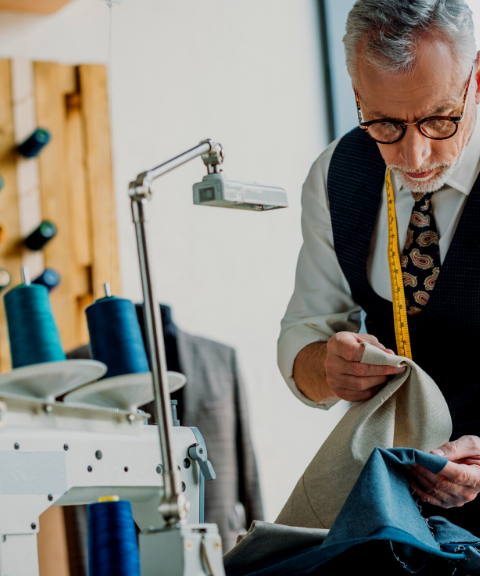Tailor Perth Specialists: Tailor-Made Solutions for Elegant Clothing
Tailor Perth Specialists: Tailor-Made Solutions for Elegant Clothing
Blog Article
Understanding the Tailoring Refine: From Textile Option to Last Fitting for the Perfect Closet
The customizing procedure is an intricate interaction of art and science, beginning with the crucial choice of material option and finishing in the accurate adjustments of final installations. Each material kind brings unique high qualities that affect not only the visual appeal however also the garment's longevity and viability for various occasions. Recognizing the nuances of customizing strategies can boost one's closet to unmatched levels of refinement. As we check out these aspects additionally, one should think about just how also the smallest information can dramatically influence the general result of one's personal design.
Value of Material Option
Picking the best fabric is vital in the tailoring procedure, as it directly influences the comfort, durability, and overall visual of the last garment (tailor perth). The selection of textile sets the foundation for the garment's design, performance, and capability. Various materials possess one-of-a-kind properties, such as breathability, stretch, and weight, which can substantially influence just how the garment drapes and fits the body
Moreover, material option influences the garment's long life and convenience of care. High-grade fabrics can hold up against deterioration, keeping their look and framework with time, while lower-quality materials may bring about pilling or fading. Additionally, the best textile adds to the garment's capacity to change across periods and occasions, consequently boosting adaptability.
A customized item made from a suitable material not just showcases craftsmanship however also elevates the user's confidence. Recognizing the subtleties of textile option is critical for any customizing undertaking. It ensures that the final item not just satisfies the visual needs of the client however likewise aligns with useful needs, consequently accomplishing a harmonious equilibrium between type and feature in the tailored wardrobe.
Kinds Of Fabrics and Their Usages
Understanding the different types of materials available is vital for making educated choices throughout the customizing process. Each material possesses distinct features that dictate its suitability for particular garments and celebrations.
Its adaptability allows it to be customized into every little thing from shirts to outfits. Its all-natural flexibility helps garments preserve shape over time.
Silk exhibits high-end and is lightweight, making it ideal for eveningwear and delicate blouses; nonetheless, it calls for mindful handling because of its fragility. Bed linen, with its textured coating, is a popular option for warm environments, providing a airy and crisp feel, however it wrinkles quickly, which may affect the garment's look.
Synthetic textiles, such as polyester and nylon, deal toughness and resistance to creases, making them suitable for daily wear and energetic garments. Recognizing these material kinds and their properties allows for far better decision-making, guaranteeing that each tailored item not only fits well but additionally lines up with the intended purpose and event.
The Tailoring Methods Clarified
The art of customizing relies upon a selection of methods that change textile into well-fitted garments. Central to this procedure is pattern drafting, where a dressmaker produces design templates based on the client's dimensions and desired design. This initial step makes certain that the garment will fit the wearer effectively before any type of reducing takes place.
When patterns are developed, cutting methods enter into play. Precision is critical as mistakes can result in misfitting garments. Tailors often make use of numerous cutting methods, such as single-layer cutting for detailed styles and multiple-layer cutting for effectiveness on common patterns.
Basting is an additional essential technique, enabling dressmakers to temporarily stitch textile items with each other for a preliminary fitting. This method provides the chance to analyze the drape and total shape before final stitching.
Seaming methods, including flat-felled joints and French seams, enhance the garment's longevity and visual charm. Tailors additionally use methods such as interfacing and extra padding to supply structure and shape to specific areas, like shoulders and collars.
Finally, completing strategies, consisting of hemming and side finishing, make sure the garment's longevity while supplying a polished look. With each other, these techniques form the backbone of reliable tailoring, causing elegant, custom-fit apparel.
Fitting Modifications and Factors To Consider

Secret considerations consist of the shoulder fit, which needs to neither sag nor restrict movement, and the sleeve size, which need to permit for comfortable arm movement while keeping a polished look. Furthermore, modifications at the midsection can fine-tune the shape, with alternatives to allow out or absorb fabric as needed.
The surge of trousers is one more critical element; it must rest easily over the hips without triggering discomfort, allowing for simplicity of activity. Hemming sizes for both pants and skirts must reflect the wearer's recommended style while valuing proportions.

Keeping Your Tailored Garments
Always comply with the treatment tag directions, which might recommend completely dry cleansing for delicate textiles or device washing for even more durable materials. Avoid regular laundering, as this can wear down the fabric and modify the garment's form.
Storage space is equally important; usage padded hangers for coats and jackets to preserve shoulder framework, and store trousers folded up neatly or hung to avoid creasing. Protect garments from straight sunshine, which can fade shades and damage fibers.
Furthermore, routine inspections for minor repair services can protect against bigger issues. Look for loose look at this website switches, tearing joints, or indications of moth damage, attending to these issues without delay to maintain the garment's stability.
Lastly, think about seasonal turning. Using tailored items in small amounts permits textiles to recover, expanding their lifespan. By executing these upkeep methods, you can make certain that your tailored garments stay as beautiful as the day you first wore pop over to this web-site them, enhancing your optimal wardrobe for several years to come.
Conclusion
The customizing procedure, incorporating material choice, experienced techniques, and accurate fitting adjustments, plays a crucial function in producing garments that boost both comfort and design. Recognizing the significance of maintenance expands the life of customized garments, strengthening their worth in a well-curated closet.
Choosing the appropriate fabric is essential in the customizing procedure, as it directly affects the comfort, toughness, and general visual of the final garment. The selection of material sets the foundation for the garment's design, efficiency, and functionality. Different fabrics possess distinct residential or commercial properties, such as breathability, weight, and stretch, which can dramatically impact exactly how the garment drapes and fits the body.
The art of tailoring depends on a variety of strategies that transform material right this hyperlink into well-fitted garments.The customizing procedure, including fabric choice, skilled techniques, and specific fitting changes, plays an essential function in creating garments that enhance both comfort and style.
Report this page